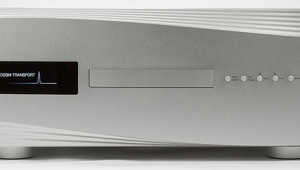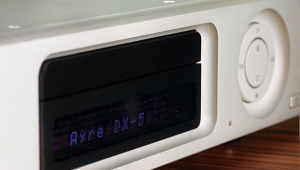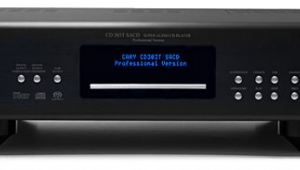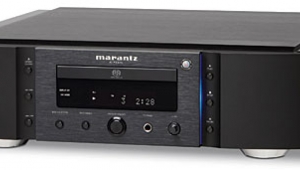| Columns Retired Columns & Blogs |
Krell Evolution 505 SACD/CD player
Spending $10,000 for a machine that spins CDs and SACDs may seem extravagant in an age when the latter format is pretty much dried up and the former seems headed there. But hold on—there are reasons for the Krell Evolution 505's five-figure price, and a payoff, too.

The Evolution 505 is massive for a CD player: 29 lbs, a half-foot high, nearly a foot-and-a-half wide and deep. The aircraft-grade aluminum chassis, which comes in silver or black, has rounded edges and slitted sides that give its bulk a streamlined grace. Like the power and preamplifiers in the Evolution series, the 505 incorporates Krell's proprietary CAST circuitry, and therein lies much of the reason for its cost. . . and that payoff I mentioned.
As I outlined in my review of the FBI integrated amplifier in the July 2007 Stereophile (Vol.30 No.7), Krell's proprietary Current Audio Signal Transmission (CAST) circuit manipulates the audio signal in the current domain instead of in the typical voltage domain. It does this in the circuits within a component, and also—through CAST outputs—the connections between components. Of course, to go this route, you'd need a Krell preamp with CAST inputs (more on that later).
In theory, this approach has two advantages. First, the signal doesn't have to be converted from current to voltage and back to current; it flows as one continuous stream of current. Second, whereas signals in the voltage domain go from low impedance to high impedance, signals in the current domain go in the opposite direction. As a result, factors that inevitably corrupt an audio signal—stray capacitance and inductance on a circuit board, unpredictable effects caused by mismatched impedance of interconnect cables, and so on—are said to be dramatically reduced, if not eliminated.
One drawback of operating in the current domain is that, watt for watt, it requires twice as many transistors as the voltage domain. This means that the component must be bigger and heavier, and run hotter—and, consequently, will cost more to build and to buy.
There are other reasons for the high cost. Most visibly, there's the damped chassis of aircraft-grade aluminum; the transport itself sits on a rigid subchassis of the same material. The disc drawer is mounted on a steel plate to maximize disc-reading accuracy. There are also two discrete sets of anti-aliasing filters: one for CD, one for SACD. All circuits run in class-A, with separate output stages for CD and SACD. There are two linear power supplies, one for the digital circuitry, one for the analog, each with discrete regulators and heavy toroidal transformers to control the pattern of radiation. Three Burr-Brown PCM1738 DACs, each capable of handling 24-bit data at a sample rate up to 192kHz, are employed, two for SACD, one for CD. And a fairly new anti-jitter circuit, retrofitted since the first units came off the production line, is said to reduce the already-low rate of jitter between the transport section and the DAC by a factor of five (again, more on this below).
Back to CAST: The advantage of manipulating signals in the current mode is that it allows for much wider bandwidth. Bret D'Agostino of Krell tells me that, while signals in the voltage domain can achieve a bandwidth of about 300kHz, the Evolution 505 has a bandwidth of 1MHz.
Does this matter? CDs encode data up to 22kHz, meaning a CD player doesn't need more than a bandwidth of around 44kHz to operate. But because "brick-wall" anti-aliasing filters are difficult to manufacture and optimize, manufacturers long ago made use of oversampling to increase the signal bandwidth, and thus allow for smoother filters and lower distortion. The DSD encoding used on SACD has a bandwidth of 100kHz, which is thought to be the main reason the best of them sound so good, so "analog-like." But 1 megahertz—ie, 1000kHz? Is that overkill?
Bret D'Agostino says no. The more bandwidth, the less noise; the less noise, the greater detail, depth, and transparency in the music—a relationship that holds, he insists, at least all the way up to 1MHz. I have no way to evaluate this claim scientifically. All I can do is listen.
Setup
I did all of my listening through Verity Audio's Parsifal Ovation loudspeakers and Krell's own FBI integrated amplifier, using the latter's CAST inputs and, for comparison, its balanced inputs. Though I didn't have it on hand, I once spent a lot of time with the Evolution 505's non-CAST predecessor, Krell's SACD Standard (some of that time hooked up to the FBI and the Parsifals), with which I was able to make rough comparisons. Cables in all cases were by Nirvana, except for the special, 4-pin, bayonet-connector CAST cables, for which I used Krell's own and, toward the end of the listening, Nordost's. (I think those are the only two makes on the market.)
I placed the 505 on three Black Diamond Mk.IV Racing Cones (which, as they do with most electronics, tightened transients somewhat), and plugged the 505's power cord into Bybee Technologies' Signature Model Power Purifier, as well as straight into my hospital-grade wall sockets (the FBI is always plugged straight into these), which are wired to a dedicated 20-amp power circuit installed long ago by an electrician, and still, by far, my most cost-effective audio upgrade.
- Log in or register to post comments




































